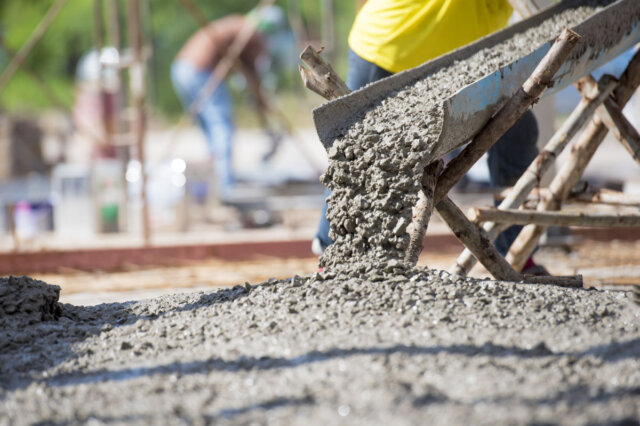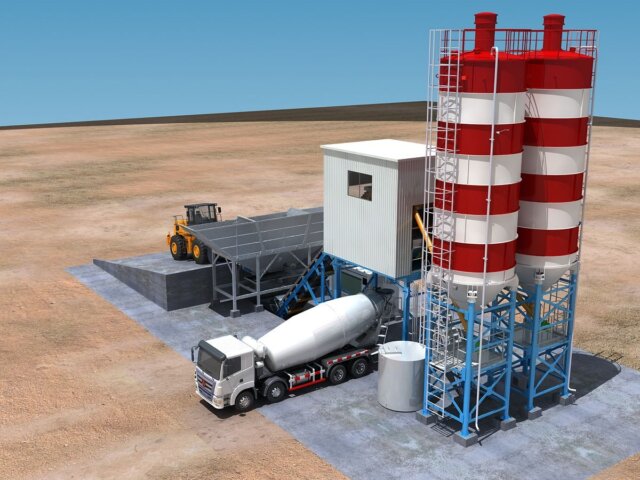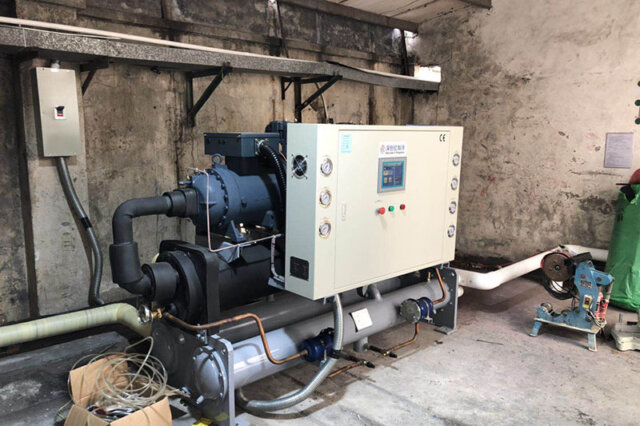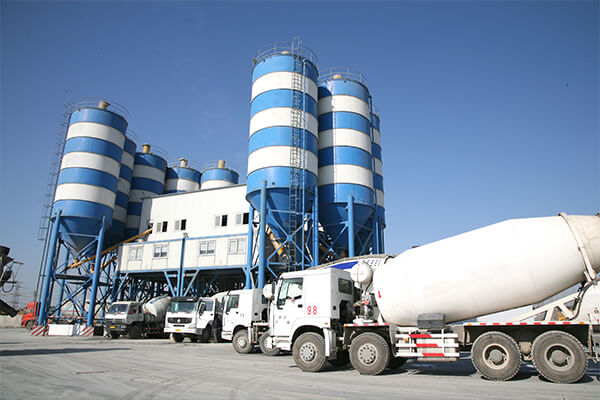Concrete Batch Plant Challenges
Concrete batch plants must manage temperature variations that critically affect concrete quality and consistency. Fluctuations in ambient temperature can cause uneven curing and weakened concrete strength. Precise temperature control, especially in extreme weather, is vital for uniform curing and maintaining concrete integrity. Addressing these temperature challenges is essential for enhancing concrete quality and consistency, ensuring the structural integrity and longevity of construction projects.
Why Temperature Control is Important in Concrete Production
During summer, freshly mixed concrete can overheat. Utilizing concrete exceeding specified temperatures for certain applications significantly weakens its overall strength. Thus, temperature control in concrete batch plants is essential, impacting every phase of concrete production and application, and ensuring the mix’s integrity.

- Optimal Hydration Reaction: The hydration of cement, which is the reaction between cement and water, is highly temperature-dependent. Too high a temperature can accelerate the hydration, leading to rapid setting and potentially weaker concrete. On the other hand, too low a temperature slows down the hydration, extending setting times and delaying construction schedules. Proper temperature control ensures a consistent and optimal hydration reaction, leading to a stronger and more durable concrete.
- Quality and Consistency: Temperature impacts the consistency of the concrete mix and its workability. Managing the temperature helps in producing uniform batches of concrete with the desired slump and workability, essential for quality construction practices and achieving the expected finish.
- Thermal Cracking Prevention: Extreme temperature differences within the concrete can lead to thermal cracking, compromising the structural integrity of the finished product. Controlling the temperature of the mix helps in reducing the risk of such cracking, especially in large or complex concrete structures.
- Improved Workability and Handling: Concrete at the right temperature is easier to work with and can be transported, placed, and finished more effectively. This not only improves the efficiency of the construction process but also leads to better overall results.
- Seasonal Adaptability: In varying climates and across seasons, the ambient temperature can dramatically affect the concrete curing process. Temperature control allows for adaptability, ensuring high-quality concrete production year-round, irrespective of external temperature conditions.
- Longevity and Durability: Ultimately, the temperature of concrete at the time of mixing, placing, and curing has a long-term impact on its durability and strength. Properly controlled temperature conditions lead to concrete structures that meet all specifications and last for their intended lifespan.
Which Step of Concrete Making Uses Chilled Water
The chilled water in a concrete batching plant is primarily used during the mixing phase. Here’s the whole concret-making process.
Batching
This is the initial stage where all the ingredients of concrete (cement, aggregates, and water) are measured and prepared for mixing. The temperature of the water is essential here, especially in hot climates, to ensure the quality and workability of the concrete.
Mixing
Once all the ingredients are batched according to the desired concrete recipe, they are mixed together. It is at this stage that the chilled water is used. The cold water helps control the temperature of the concrete mix. Controlling the temperature is crucial because it affects the hydration process of the cement, the setting time, and ultimately the strength and structural integrity of the concrete.
Transporting
After mixing, the concrete is often transported to the site where it will be poured. Even during this phase, temperature control is essential to prevent the concrete from setting prematurely or developing undesirable properties.

Pouring and Curing
While the chilled water is not directly used in these stages, the effects of using chilled water during the mixing phase carry on. The temperature of the mix at the time of pouring is crucial for the curing process and the final quality of the concrete.
Optimal Temperature For Chilled Water In Concrete Mixing Step
The optimal temperature of chilled water used in the mixing step of concrete varies depending on various factors such as ambient temperature, specific concrete mix design, and the desired characteristics of the concrete. However, generally:
- The temperature of the chilled water is usually kept around 1°C to 7°C (34°F to 45°F).
- The target is typically to maintain the concrete mix temperature at or below 26°C (78.8°F), though this can vary depending on specific standards and regulations.
It’s crucial to consider that the goal isn’t just about the water temperature but ensuring the overall concrete temperature remains within a range conducive to optimal hydration and setting times. Construction professionals often refer to guidelines provided by standards organizations, such as the American Concrete Institute (ACI) or equivalent bodies in their region, and may adjust the water temperature based on specific project needs, ambient conditions, and the type of concrete being used.
What is a Batching Plant Chiller?
Batching plant chillers are integral in maintaining the ideal temperature of concrete, ensuring quality and consistency in production. They are designed to withstand the harsh conditions of a dusty batching site and operate efficiently under various weather conditions, including intense sun and rain.

How Does it Work?
Batching plant chillers function by cooling the water that is mixed with cement and aggregates. This chilled water directly controls the temperature of the concrete mix, ensuring it remains within the optimal range for hydration and setting. The chillers are equipped with components selected specifically for the conditions and requirements of the batching process. This includes robust construction to withstand the dusty and harsh environments of construction sites.
The chillers work by extracting heat from the water through a refrigeration cycle, involving compressors, condensers, and evaporators, and then circulating the cooled water back into the concrete mix. This process is crucial in maintaining the desired consistency and quality of the concrete, especially in hot climates or during warm weather conditions.
Size of Water Chiller Needed
The size of the water chiller needed for a concrete batching plant is primarily determined by the thermal load capacity required for concrete applications. This depends on several factors, including the volume of concrete produced, ambient temperature conditions, and specific project requirements.

Our range of water-cooled chillers typically extends from 30 to 200 tons, catering to a wide variety of operational scales and environmental conditions.
Air-cooled chillers are commonly installed due to their ease of installation and general efficiency. They are suitable for most concrete cooling applications and are preferred for their relative simplicity and lower maintenance needs. However, water-cooled chillers might be chosen for their higher energy efficiency, especially in settings where energy conservation is a priority.
The engineering team must conduct a comprehensive study of the batching process requirements to choose the appropriate size and type of chiller. This includes understanding the daily volume of concrete, peak temperatures, and any specific client or project needs. The goal is to provide a batching plant chiller that maintains operational efficiency and energy effectiveness at an affordable cost, specifically tailored for extreme tropical weather conditions or any challenging operational environment.
There are also specific rules for low temperature(lower than 5°c) chiller sizing. Please feel free to contact us.
There are also specific rules for low temperature(lower than 5°c) chiller sizing. Please feel free to contact us.
Installation Considerations for Batching Plant Chillers
When integrating chillers into a concrete batching plant, several key considerations must be addressed to ensure effective and efficient installation. Proper planning and understanding of these factors can significantly affect the chiller’s performance and the overall operation of the batching plant.
- Space and Placement: Evaluate the available space for installing the chiller. It should be easily accessible for maintenance and repair while ensuring it does not interfere with the routine operations of the batching plant. Consideration of ambient conditions is also crucial; the chiller should be placed in a location where it can operate efficiently without being affected by extreme temperatures or direct sunlight.
- Power Supply and Electrical Requirements: Ensure that the installation site has the appropriate electrical infrastructure to support the chiller’s operation. This includes checking voltage, phase, and amperage requirements and ensuring that electrical connections are safe and comply with local codes and regulations.
- Water Supply and Piping: The chiller needs a steady and reliable water supply. Assess the water source’s quality and availability and plan for adequate piping to and from the chiller. The piping should be designed to minimize heat gain or loss and prevent any leakage or contamination.
- Integration with Batching System: The chiller must be seamlessly integrated with the existing batching plant controls and processes. This integration should allow for easy monitoring and adjustment of water temperature according to varying production needs and external conditions.
- Cooling Capacity and Scalability: Choose a chiller with the appropriate cooling capacity for your specific batching plant. It’s also wise to consider future needs; a scalable system can accommodate potential expansion or increased production capacity without requiring a complete system overhaul.
- Maintenance Access: Regular maintenance is vital for the chiller’s longevity and efficiency. Ensure that the chiller is installed in a way that allows easy access for routine inspections, cleaning, and repairs.
- Environmental Regulations and Safety: Comply with all local environmental and safety regulations related to chiller installation and operation. This includes proper handling and disposal of refrigerants and ensuring all safety protocols are followed to protect workers and the environment.
- Expert Installation: Considering the complexity and importance of chillers in the batching plant, professional installation by experienced technicians is recommended. They can ensure that the chiller is installed correctly and optimized for the plant’s specific needs.
By carefully considering these factors during the installation of a batching plant chiller, you can ensure efficient, reliable, and effective cooling performance, contributing to the consistent production of high-quality concrete.
Conclusion
Effective temperature control via chillers is essential in concrete batch plants for producing high-quality concrete. By mitigating temperature variations and optimizing hydration, chillers enhance the concrete’s strength, workability, and durability. The selection, installation, and maintenance of chillers are critical, requiring careful consideration of plant needs and environmental conditions. Ultimately, investing in the right chiller system significantly contributes to the structural integrity and longevity of construction projects, reflecting the industry’s commitment to excellence and sustainability.

اريد تبريد ماء لخرسانه بسعه ٦٥ الف رتل من الماء من درجه ٤٠ درجه الا ٢٦ درجه خلال ساعتين
ماهو البرج المناسب لها اوالشيلر